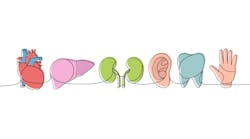Editor's note: This is part two of a two-part series. Read part one.
In part one of this series, we discussed the terms and local effects of why periodontal disease could be a comorbidity; now we’ll look at the broader picture. Our bodies are broken down into 11 medical systems based on their functions.1 Food for thought: periodontal disease can affect every single system either through bacterial translocation or an immune or inflammatory response. Once pathogenic bacteria spreads, it can get into all parts of the body.
Circulatory/cardiovascular system: consists of the heart, blood, capillaries, blood vessels, and veins.1
Periodontal disease association: atherosclerosis, heart attack, mitral valve disease, coronary heart disease, arrhythmia, tachycardia, A-fib, endocarditis, strokes, lowered HDL, increased LDL, and elevated triglycerides.2-4
Digestive system: consists of the mouth, esophagus, stomach, liver, gallbladder, pancreas, small and large intestines, appendix, and rectum.1
Periodontal disease association: unable to chew food from tooth loss for initial proper digestion, oral and gut dysbiosis, irritable bowel syndrome, colitis, leaky gut, liver cirrhosis, nonalcoholic fatty liver disease (NAFLD), nonalcoholic steatohepatitis (NASH), and gastric ulcers.5, 6
Endocrine system: consists of hormones through chemical messengers and organs, parathyroid, thyroid, adrenal, pineal, pituitary, thymus, pancreas, ovary, and testes.1
Periodontal disease association: diabetes and insulin resistance, obesity, and polycystic ovary syndrome.4,5,6
Integumentary system: consists of skin, hair, and nails.1
Periodontal disease association: aphthous stomatitis, lichen planus, dermatitis/eczema, psoriasis, pemphigoid (including mucous membrane pemphigoid), and pyogenic granuloma.5
Lymphatic system/immune system: consists of bone marrow, spleen, white blood cells, thymus, and lymph nodes, ducts, and vessels.1
Periodontal disease association: initiates the innate and advances into acquired immune system; gum infection lowers the immune system through chronic low-grade inflammation.2
Muscular system: consists of skeletal (all bones), smooth (organs), and cardiac (heart) muscles.1
Periodontal disease association: affects all the vital organs: heart, liver, lungs, kidneys, and brain. Nonvital organs: large intestine, gallbladder, pancreas, stomach, and appendix.
Nervous system: consists of central nervous system (spinal cord and brain) and peripheral nervous system (nerves all throughout the body).1
Periodontal disease association: Alzheimer’s, dementia, Parkinson’s, and depression.2,5
Reproductive system: consists of the uterus, ovaries, vagina, penis, and testicles.1
Periodontal disease association: low birth weight, preterm birth, gestational diabetes mellitus, fetal infections, miscarriage, preeclampsia, and infertility (both male and female).4,7-10
Respiratory system: consists of nasal, pharynx, larynx, trachea, lungs, bronchi, bronchioles, and diaphragm.1
Periodontal disease association: chronic obstructive pulmonary disease, bacterial pneumonia, bronchitis, emphysema, respiratory tract infection, asthma, and pharyngitis.4-6
Skeletal system: consists of all skeletal bones.1
Periodontal disease association: rheumatoid arthritis, osteoporosis, osteopenia, bone marrow alteration, and alveolar bone loss.4,5
Urinary system: consists of the kidneys, bladder, ureters, and urethra.1
Periodontal disease association: chronic kidney disease, urinary tract infections, interstitial cystitis, end-stage renal disease, and glomerulonephritis.3,9,11
Having comorbidities is associated with:
- Impaired function
- Worsened physical and mental health
- Reduced quality of life
- Increased death
- Poly pharmaceuticals
- Involvement of multiple health-care providers1
More facts that periodontal disease can be considered a comorbidity:
- A medical clearance is needed for certain surgeries.
- Premedication is needed for certain medical procedures.
- Some insurances cover extra cleanings to reduce bacterial load for the health of certain medical conditions.
This suggests that the mouth needs to be healthy for other areas of the body to succeed.
Areas comorbidity diseases can influence
Disease prevention: Managing one comorbidity can improve or prevent another.
Health improvements: After having periodontal therapy (noninvasive or invasive), the risk is lowered with many medical conditions. Active periodontal disease lowers the immune system, which worsens the ability to fight off the common cold/flu, autoimmune diseases, and cancer recovery, to name a few.
Having one condition can worsen another condition: Active periodontal disease can negatively influence other medical conditions such as diabetes, pregnancy, and cardiovascular risks.
Treatment can be more complex involving not only multiple but a variety of specialists: For instance, as we know, diabetes affects periodontal disease and periodontal disease affects diabetes. If oral infection is present, it can increase blood sugars and make it harder to stabilize. When both conditions are present, they can be a supplementary danger to each other, so a periodontist and an endocrinologist may be involved. If other comorbidities are involved, the list of specialists is increased.
What other disease, beyond periodontal disease, can cause chaos at a systemic level? One that comes to mind is cancer. If cancer does not stay localized, it metastasizes to become fatal. And we know periodontal bacteria doesn’t stay localized as we need to eat, swallow, and breathe, which transports the pathogenic bacteria to the rest of the body. This may be risky through the connection of cancer with periodontal disease.
Cancers affected: Breast, lung, non-Hodgkin’s lymphoma, cervix, oropharyngeal, prostate, pancreatic, digestive tract tumors, gastrointestinal, colorectal, esophageal, gastric, oral squamous cell carcinoma, lung cancer, kidney, and blood. 2,5
Other periodontal disease connections
Autoimmune diseases affected: Rheumatoid arthritis, systemic lupus erythematosus, and inflammatory bowel disease.2,5
Periodontal disease is not deadly in and of itself, but it can, by bacterial translocation, increase the risk of a severe or fatal (heart attack, stroke) result. Another thought is if a patient has comorbidities along with periodontal disease, should there be a more severe classification? It is rare for periodontal disease to stand alone. In my clinical experience, patients who have periodontal disease tend to have one or more other medical conditions. Should there be a periodontal stage 5 (poor oral health) or a grade D (multiple comorbidities) to suggest a higher risk of concern?
Due to the possibility of systemic circulation of periodontal infection through the bloodstream, caution should be taken. Do we know absolutely that pathogenic bacteria is spreading without measuring bacteria in certain parts of the body? No, but by looking in the mouth and noting its heavy biofilm and bleeding, we can suggest that it is a likely event.
Patients are different in how they respond to periodontal disease. Some don’t mind losing their teeth, while some care a lot about losing their teeth. Some don’t mind tasting blood and smelling infection, and some are very self-conscious about it. Some don’t mind the uncomfortable cleanings, and some mind enough to brush and floss. Patients tend to determine the status of their mouth and health either by the way it feels or looks esthetically.
I had one patient who was on his sixth round of quad scales. This is the type of patient who may be at most risk for periodontal disease as a comorbidity. The patient has sporadic dental visits with a minimum of four-year intervals. He has been living with chronic periodontal disease for years and stated “no health concerns” as he doesn’t visit the medical profession often either. This makes the unknown perilous. A “no known medical history” is worse than a detailed one.
To wrap this up, we can have co- (multi-) morbidities just in the mouth itself. A patient can have periodontal disease, rampant decay, and xerostomia—all contributing to their own set of problems. Then add smoking, medications, drug and alcohol use, and overall poor health to create a perfect storm for poor oral health.
Many patients have comorbidities, so they are aware of this term. Telling a patient their periodontal disease isn’t only affecting their teeth, bone, and gums but also affecting their heart, lungs, and diabetes may be more impactful and taken seriously. Letting a patient know they have the comorbidity of periodontal disease may stir motivation for better home care and assertiveness for their oral and systemic health.
Editor's note: This article appeared in the June 2025 print edition of RDH magazine. Dental hygienists in North America are eligible for a complimentary print subscription. Sign up here.
References
- Brouhard R. The 11 organ systems of the body and how they work. Verywell Health. Updated September 19, 2024. Accessed January 4, 2024. https://www.verywellhealth.com/organ-system-1298691
- Martínez-García M, Hernández-Lemus E. Periodontal inflammation and systemic diseases: an overview. Front Physiol. 2021;12:709438. doi:10.3389/fphys.2021.709438
- Leelaviwat N, Kewcharoen J, Poomprakobsri K, et al. Periodontal disease and risk of atrial fibrillation or atrial flutter: a systematic review and meta-analysis. J Arrhythm. 2023;39(6)L992-996. doi:10.1002/joa3.12921
- Lohiya DV, Mehendale AM, Lohiya DV, Lahoti HS, Agrawal VN. Effects of periodontitis on major organ systems. Cureus. 2023;15(9):e46299. doi:10.7759/cureus.46299
- Hajishengallis G, Chavakis T. Local and systemic mechanisms linking periodontal disease and inflammatory comorbidities. Nat Rev Immunol. 2021;21(7):426-440. doi:10.1038/s41577-020-00488-6
- Li X, Kolltveit KM, Tronstad L, Olsen I. Systemic diseases caused by oral infection. Clin Microbiol Rev. 2000;13(4):547-558. doi:10.1128/CMR.13.4.547
- Macklis P, Adams K, Kaffenberger J, Kumar P, Krispinsky A, Kaffenberger B. The association between oral health and skin disease. J Clin Aesthet Dermatol. 2020;13(6):48-53.
- Akcalı A, Bostanci N, Özçaka Ö, et al. Association between polycystic ovary syndrome, oral microbiota, and systemic antibody responses. PloS One. 2014;9(9):e108074. doi:10.1371/journal.pone.0108074
- Ludovichetti FS, Signoriello AG, Gobbato EA, Artuso A, Stellini E, Mazzoleni S. Can periodontal disease affect conception? A literature review. Reprod Fertil. 2021;2(1):R27-R34. doi:10.1530/RAF-20-0043
- Penmetsa GS, Meghana K, Bhavana P, Venkatalakshmi M, Bypalli V, Lakshmi B. Awareness, attitude and knowledge regarding oral health among pregnant women: a comparative study. Niger Med J. 2018;59(6):70-73. doi:10.4103/nmj.NMJ_151_18
- Ardalan MR, Ghabili K, Pourabbas R, Shoja MM. A causative link between periodontal disease and glomerulonephritis: a preliminary study. Ther Clin Risk Manag. 2011;7:93-98. doi:10.2147/TCRM.S14106
About the Author

Lara James, NTM, RDH
Lara James, NTM, RDH, is a licensed dental hygienist of clinical hygiene, including corporate, dental management, and private practices. She graduated in 2004 from Portland Community College in Portland, Oregon. Lara also has written an online continuing education course on Dentalcare.com. She has a Nutritional Therapy Master’s (NTM) certificate and promotes healthy eating.

